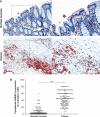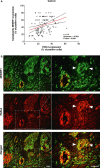High density of tryptase-positive mast cells in human colorectal cancer: a poor prognostic factor related to protease-activated receptor 2 expression
- PMID: 23991686
- PMCID: PMC3780541
- DOI: 10.1111/jcmm.12073
High density of tryptase-positive mast cells in human colorectal cancer: a poor prognostic factor related to protease-activated receptor 2 expression
Abstract
Tryptase(+) mast cells (MCs), abundant in the invasive front of tumours, contribute to tissue remodelling. Indeed, protease-activated receptor-2 (PAR-2) activation by MC-tryptase is considered an oncogenic event in colorectal cancer (CRC). Recently, we have suggested NHERF1 as a potential new marker in CRC. In this study, we aimed to determine the distribution of tryptase(+) MCs and PAR-2 and to examine the relationship between PAR-2 and NHERF1, investigating their reputed usefulness as tumour markers. We studied a cohort of 115 CRC specimens including primary cancer (C) and adjacent normal mucosa (NM) by immunohistochemical double staining, analyzing the protein expression of MC-tryptase, PAR-2 and cytoplasmic NHERF1. MC density was higher in NM than in C. Tumours with high TNM stage and poor grade showed the highest MC density. A higher PAR-2 immunoreactivity characterized tumours most infiltrated by MCs compared with samples with low MC density. Furthermore, PAR-2 overexpression was associated with advanced TNM stage, poor grade and lymphovascular invasion (LVI). A positive correlation existed between tryptase(+) MC density and PAR-2 expression. Cytoplasmic NHERF1 was higher in C than in NM and overexpressing tumours resulted associated with nodal and distant metastases, poor grade and LVI. PAR-2 correlated with cytoplasmic NHERF1 and the PAR-2(+)/cytoplasmic NHERF1(+) expression immunophenotype identified tumours associated with unfavourable prognosis and aggressive clinical parameters. Our data indicate that the high density of tryptase(+) MCs at invasive margins of tumours was associated with advanced stages of CRC and was strongly correlated with PAR-2 expression.
Keywords: Colorectal cancer; NHERF1; PAR-2; aggressiveness; invasiveness; mast cell; prognostic factor; tryptase.
© 2013 The Authors. Journal of Cellular and Molecular Medicine Published by Foundation for Cellular and Molecular Medicine/Blackwell Publishing Ltd.
Figures





References
-
- Colotta F, Allavena P, Sica A, et al. Cancer-related inflammation, the seventh hallmark of cancer: links to genetic instability. Carcinogenesis. 2009;30:1073–81. - PubMed
-
- Pages F, Galon J, Dieu-Nosjean MC, et al. Immune infiltration in human tumors: a prognostic factor that should not be ignored. Oncogene. 2010;29:1093–102. - PubMed
MeSH terms
Substances
LinkOut - more resources
Full Text Sources
Other Literature Sources
Medical
Miscellaneous

